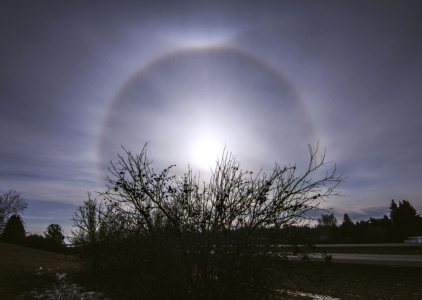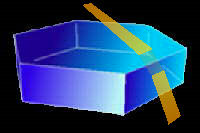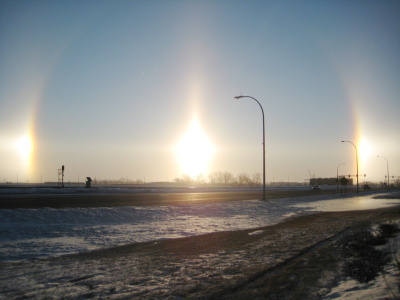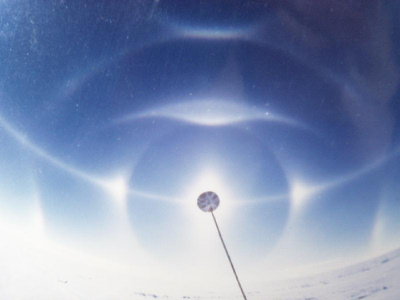|
| Beatufiful displays that come from ice crystals |
|
 Ghostly Rings Ghostly Rings
Atmospheric
halos sometimes appear around the sun or moon when there are ice
crystals in the air, usually at high altitude. The most common is the
22-degree halo, so-called because the angle between the center and the
ring is 22 degrees. (If you straighten your arm and stretch your hand
out as far as you can, 22 degrees is roughly the angle you
see from the tip of your thumb to the tip of your pinky.)
This photo shows an example of a 22-degree halo, taken by Zachary Stisser, as seen on his Flickr photostream.
22-degree
halos are fairly common in winter; people often miss them because they
are not looking up! If you see thin cirrus clouds in the sky, you might
see this halo. One trick is to stand where so top of a pole blocks the
sun (for example the light poles above parking lots); that makes it
much easier to see the halo. Look for this halo around a bright moon
also. |
|  Reflections from Ice Crystals Reflections from Ice Crystals
The 22-degree halo is a result of reflections from faceted ice crystals. If the crystals look like simple hexagonal prisms (see Snowflake Science),
then not all reflection angles are equally likely. The math is not
simple, but it turns out that the most likely reflection angle is 22
degrees.
The quality of the halo depends on the quality of the
ice crystals. Nicely faceted crystals give good halos, while more
gloppy crystals give lousy halos. What you will see is hard to predict
-- you just have to keep looking! |
|  Sun Dogs Sun Dogs
The
sun dogs are bright spots that sometimes appear on either side of the
sun. Again the angle between the sun and the dogs is 22 degrees. Sun
dogs can only be seen when the sun is low in the sky, such as right
before sunset.
Sun dogs are also caused by reflections from
faceted ice crystals, but this time the crystals are aligned relative
to the horizon. This happens when the air is very still, allowing the
crystals to align from aerodynamics as they slowly fall.
[public domain photo from Wikepedia, uploaded by Gopherboy6956] |
|  Antarctic Halos Antarctic Halos
The
most exotic halo displays have been found at the South Pole. This one
was photographed by Walter Tape. The bitter cold, dry climate sometimes
fills the air with nearly perfectly faceted ice crystals, that are also
aerodynamically aligned, producing a variety of unusual arcs, rings,
and spots. Even at the South Pole, displays like this one are
exceedingly rare. |
| Keep Looking Up
Your
mission, should you decide to accept it, is to keep your eyes open for
halo displays, especially when the weather is cold and ice crystals are
more common. Remember those enlightening words spoken by Yogi Berra,
"You can observe a lot just by watching."
To read more about atmospheric halos, click here.
| |
|
|
|
